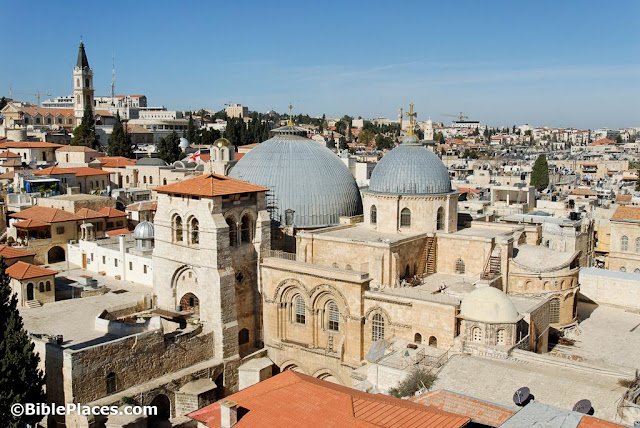The Church of the Holy Sepulchre, also known as the Church of the Resurrection, is a significant Christian pilgrimage site located in the Old City of Jerusalem. It is regarded as one of the holiest sites in Christianity and is believed to encompass the locations of Jesus Christ's crucifixion, burial, and resurrection. Here is a detailed description of the Church of the Holy Sepulchre:
Historical Background: The church's history dates back to the 4th century when Constantine the Great, the first Christian Roman emperor, legalized Christianity and ordered the construction of significant Christian sites in the Holy Land. Tradition holds that Constantine's mother, Saint Helena, discovered the True Cross and identified the sites of Jesus' crucifixion and burial.
Location: The Church of the Holy Sepulchre is situated within the Christian Quarter of the Old City of Jerusalem. It occupies a prominent position in the heart of the city, near the Damascus Gate. The church stands on a site that has been revered as holy since the early days of Christianity.
Architectural Design: The church's architectural design reflects the influence of different Christian denominations that have contributed to its construction and renovation over the centuries. The building encompasses a complex arrangement of chapels, chambers, and courtyards. It incorporates various architectural styles, including Romanesque, Byzantine, Crusader, and Ottoman.
Calvary (Golgotha): The church contains the rock of Calvary, believed to be the place where Jesus was crucified. The site is marked by a shrine called the Chapel of Calvary. It is reached by climbing a staircase and is divided into two sections: the Latin (Catholic) Calvary to the right and the Greek Orthodox Calvary to the left.
Stone of Anointing: Near the entrance of the church, there is the Stone of Anointing, also known as the Stone of Unction. According to tradition, it is the spot where the body of Jesus was prepared for burial. Pilgrims often touch or lay their belongings on the stone as an act of veneration.
Rotunda and Aedicule: The central part of the church houses the Rotunda, a circular structure that surrounds the Aedicule. The Aedicule is a small shrine that enshrines the tomb of Jesus. It is a highly revered site as it is believed to be the place where Jesus' body was laid and where his resurrection occurred. The Aedicule underwent extensive restoration in recent years to preserve its structural integrity.
Multiple Christian Denominations: The Church of the Holy Sepulchre is a unique site as it serves as a place of worship for various Christian denominations. Key custodians of the church include the Greek Orthodox, Roman Catholic, and Armenian Apostolic Churches. Other denominations, including the Coptic Orthodox, Ethiopian Orthodox, and Syrian Orthodox, also have smaller chapels within the church.
Pilgrimage Destination: The church attracts millions of pilgrims and tourists from around the world each year. Many Christians consider visiting the Church of the Holy Sepulchre as a significant part of their faith journey, seeking to connect with the events of Jesus' crucifixion, burial, and resurrection.
Historic Importance: The Church of the Holy Sepulchre holds deep historical and cultural significance. It has been a focal point of religious, artistic, and architectural endeavors throughout the centuries. The church has witnessed destruction, reconstruction, and renovations, reflecting the complex history of Jerusalem and the Christian faith.
Despite its religious and historical significance, the Church of the Holy Sepulchre has faced challenges over the centuries, including conflicts among different Christian denominations and ongoing preservation efforts. Nonetheless, it remains a central place of worship, pilgrimage, and contemplation for Christians worldwide, serving as a tangible connection to the foundational events of the Christian faith.
Source: Some or all of the content was generated using an AI language model


No comments:
Post a Comment